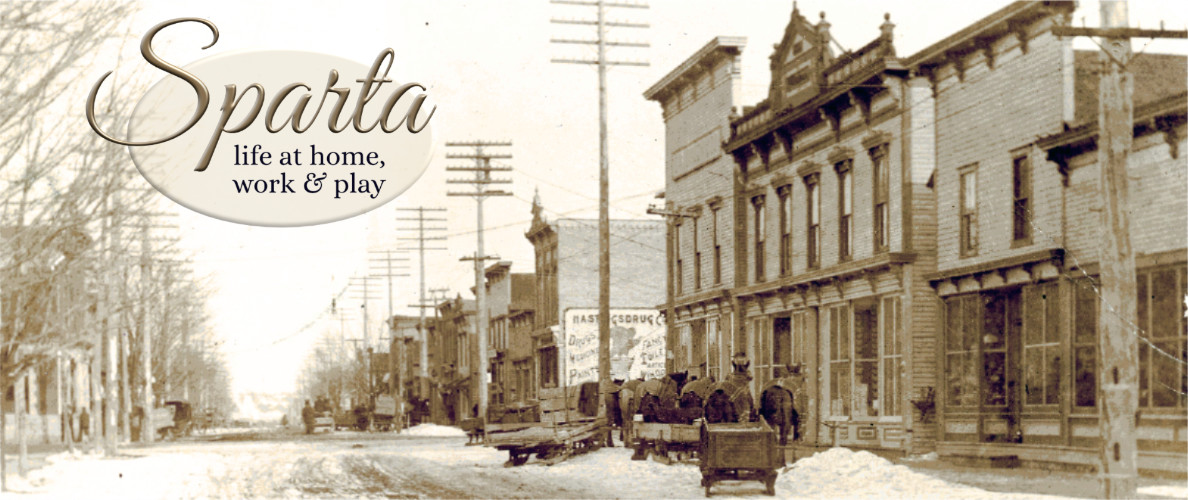

Village Articles
Competitive Spirit "Nelson A. Shaw: Horse Sense"
Businesswomen Sparta's Millinery Mavens: "Catherine Roberts & Rose Adelia Gaut: Mother-Daughter Hatters", and "Dora May Clute: Self-Made Woman"
Milo & Ben The stories of two friends and early Sparta businessmen: "Milo Bolender's Pharmacy" and "Dr. Benjamin Zudzense & His Monkeys" with "Pinckney Paints the Town"
Main Street Merchants "Charles Henry Loomis", "Frank Cnossen: There's Friendship in the Cup", and "Hugh Finch: Where You Always Do a Little Better"
Hometown Heroes "George W. Powers Murdered Lawman" and "Mad Dogs & Marshal Meeker"
The Highway Arrived State Street corridor and post-war growth: "Camp Boys Come to Town" and "Sparta Builders" addressed the housing shortage
Merry & Bright How we celebrated: "Charlie Badgerow: Two Christmas Gifts", Christmases Past", "A Very Sparta Christmas", "My Christmas Memories", and "Sparta's Easter Bunny Helper"
Hometown Heroes
George W. Powers
Murdered Lawman
Stories have been written about the brave detective who met his untimely conclusion at the hands of cowardly thieves on board a north-bound train--but questions remain. Who was the boy that grew to manhood on a Sparta farm? What effect did George's Civil War service bear upon his life journey? Where did fate play a role? When did police realize they killed the wrong man? Why did a thief get away with murder?
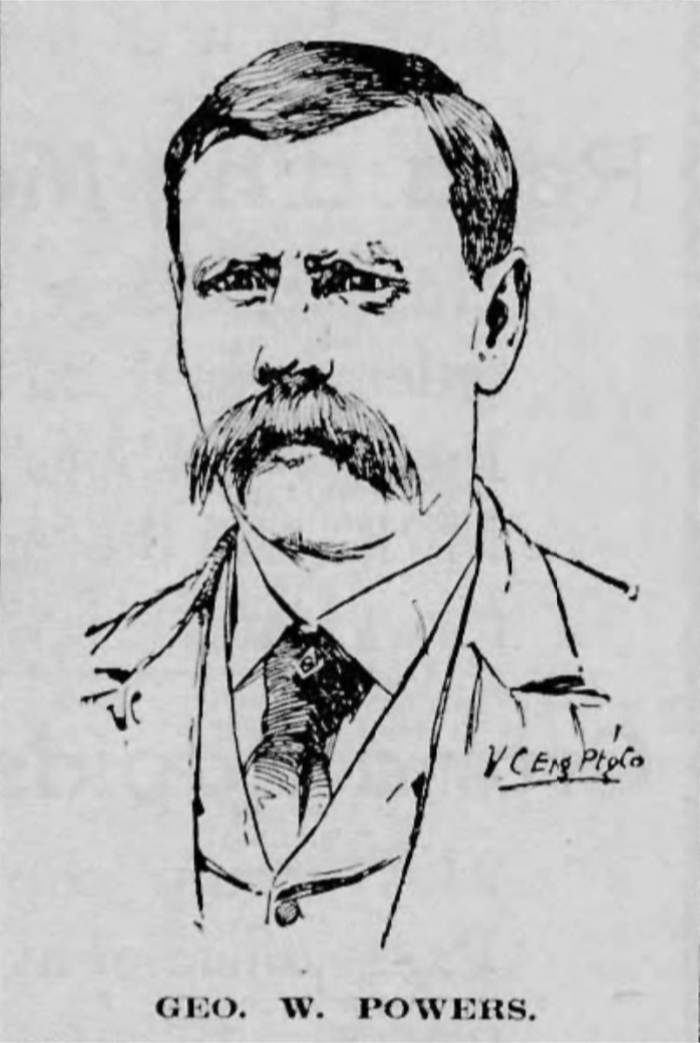
George W. Powers drawing published in The Grand Rapids Press 23 Aug 1895
Blacksmith and wagon maker, Luman A. Powers, and his wife, Jane Keeler, removed with their family from Cayuga county, New York to Kent county, Michigan the year after their first son was born. George W. Powers' birth was reportedly April 9th in 1844. Mr. Powers was described among the "early spokeshavers" who worked the trade in Albert Baxter's 1891 History of the City of Grand Rapids. Fellow wagon maker Benjamin F. Martindale also came from Cayuga county. Ben's wife, Hester Gray, was a sister to Luman's sister-in-law, Elizabeth Gray. They were part of an extended family group seeking opportunity, adventure, and a better life in Michigan.
Duty to Country
When the call to service rang out for the Civil War, young George didn't hesitate to volunteer. He left the family farm at Sparta and, on May 13th, 1861, enlisted into Company K of the Third Michigan Infantry at Grand Rapids. He volunteered to serve for three years--which implied for the duration of the war. He was so passionate about enlisting that he indicated his age was 28--though the math works out to reveal his actual age as 17 years old and too young to legally join. Nevertheless, he was among the 1,040 men under Captain Byron R. Pierce, who on the 13th of June, with the Third traveled by train and boat to join up with the Army of the Potomac at Washington DC.
By July 17th, they fought their first skirmish at Blackburn's Ford and the next day saw action at the Battle of Bull Run.
Siege of Yorktown, Seven Pines, and Fredericksburg were among the battles that brought the Third to Chancellorsville. Before Gettysburg it was the bloodiest battle in American history with 30,764 combined casualties. In the chaos following the Battle of Chancellorsville, on May 3, 1863, George was numbered among the missing in action--a designation which could include those captured or injured, as well as men who remained on the battlefield to tend the injured or assisted at understaffed hospitals. The National Museum of Civil War Medicine published the account of a wounded New York soldier's agonizing ordeal in the aftermath of this battle. He was one of more than 500 injured Union soldiers left behind on his portion of the battlefield and who was still alive the next day when a Confederate officer had survivors brought to a central location. Another day passed before four Union surgeons arrived under a truce flag but it was a week later when a Federal ambulance train transported them to Union Army hospitals.
Was George one of the soldiers who remained with his fallen comrades, then captured, and was sent to Libby prison at Richmond? "He was always accounted an exceptionally brave man. During his army service he passed through many battles, but always came out unharmed," The Grand Rapids Press later reported. "He was captured and confined in Libby prison from which place he escaped, but was taken prisoner a second time and confined at Andersonville."
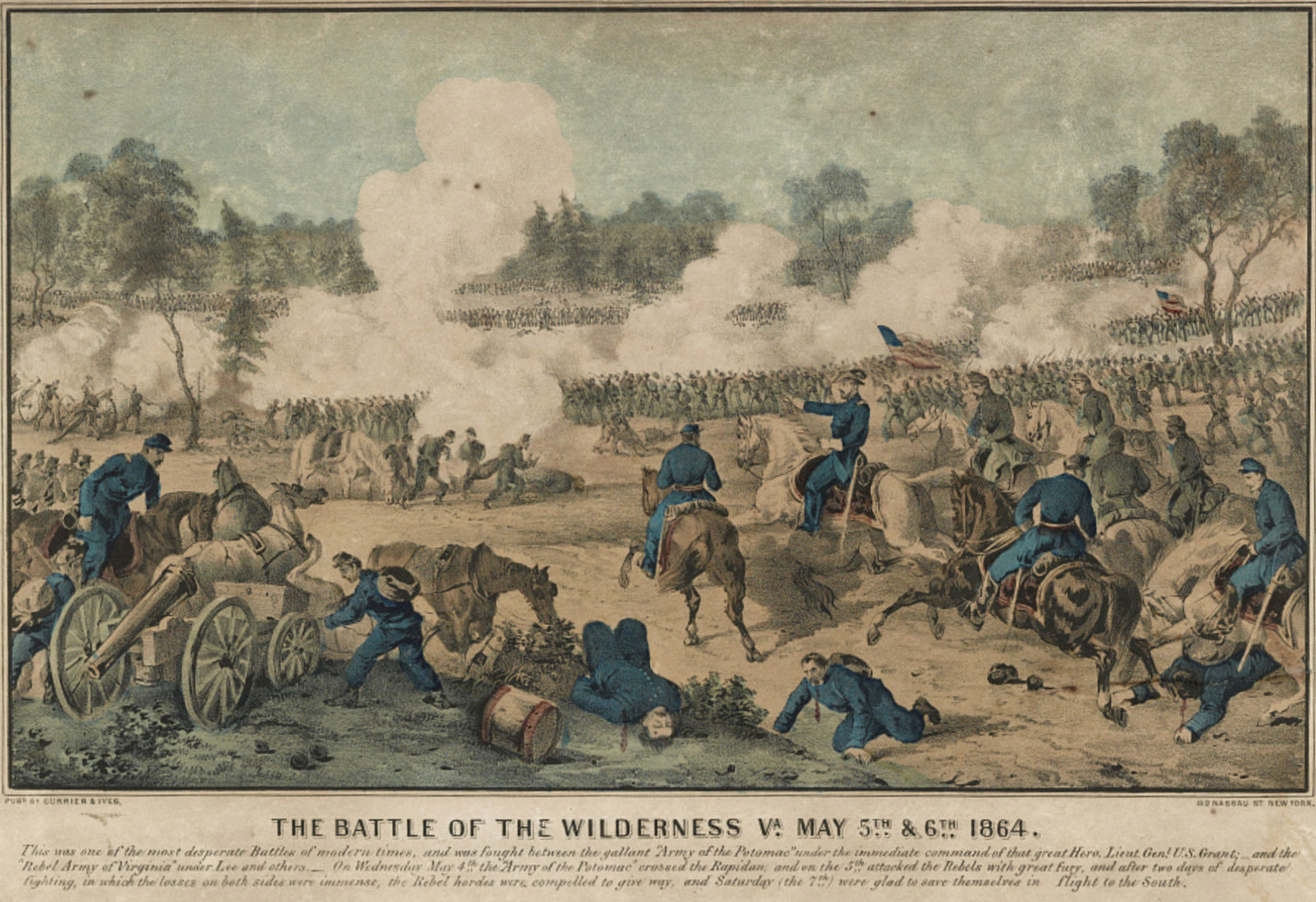
Battle of the Wilderness, Virginia, May 5th & 6th, 1864--Pubd. by Currier & Ives [1864?], Library of Congress
How George escaped from Libby is unknown, but he returned to the Third without hesitation. On Christmas Eve, he re-enlisted at Brandy Station, Virginia, and was promoted to Corporal.
Like Chancellorsville, the Wilderness fighting took place in dense impenetrable forests with limited visibility where Confederates could hide while the Union was forced to split into smaller groups. During the grueling Battle of the Wilderness, the first under General Ulysses S. Grant, the men were kept on the offensive but after two days it was evident to be a stalemate. The result was the deaths of 2,246 Union soldiers with 12,037 wounded and 3,383 taken prisoner or missing. On May 6, 1864, Corporal Powers was recorded as one of the captured.
Incarcerated at Andersonville Prison in Georgia, widely known to be a "death camp", word reached his family and friends at Sparta who feared the worse and held a funeral for the soldier. During a prisoner transfer, George along with one or two others made a daring escape--and succeeded. They traversed hostile territory and found their way back to Union lines where Corporal Powers rejoined the war effort. In the Record of Service of Michigan Volunteers in the Civil War from the Adjutant General's office, his transfer to Company I of the Fifth Infantry was recorded on June 10, 1864, at Petersburg, Virginia. He continued in service until his October 18th discharge.
Home Again
"At the close of the war he returned to his home and married Miss Emily Ewing at Sparta, with whom he had kept up a correspondence while he was fighting for the Union." The bride was the daughter of James & Louisa (Kemp) Ewing and the wedding took place on December 19th, 1866. Over the next eleven years, their family grew to include: Harriet, Edith May, Ella Louisa known as 'Lulu', and Freeling. A dark shadow was cast in 1877 when Emily was taken in death.
From boyhood through his forty-third year, George learned and practiced the skills of farming. Although just over the line into Algoma township, George's 80 acre farm on what is now 13 Mile Road, half a mile east of Division on the south side, received mail through the Sparta post office. The children attended the nearby Myers schoolhouse. Appointed as Sparta's Deputy Sheriff in 1877, he moved his family from their farm into the village where the youngsters were enrolled at the new two-story white brick school while George worked the night patrol shift.
Isadora Sharring
Love came into George's life a second time and on December 11th, 1879, a wedding was held at Sparta as he took Isadora Sharring for his wife. Born in Northumberland county, Ontario, Canada in September 1861, the bride was the "daughter of John and Julia Ann (Nelson) Sharring. She attended the graded schools, and was graduated from the high school at Sparta," according to her profile in William Harvey King's History of Homeopathy Institutions in America (1905). Her father died when she was very young, the mother married George Plumpton, a blacksmith by trade, who brought the family to Sparta. In 1880, they were neighbors of gunsmith Charles H. Loomis.
The eighteen year old accepted Sheriff Deputy Powers' proposal on one condition: "with the understanding that she be permitted to study medicine at the University of Michigan after her marriage," a (1949) article from Medical Women's Journal wrote.
True to his word, Issie "pursued a two years' course in a private school in Chicago and spent about ten years in the study of anatomy, physics and physiology prior to entering the homeopathic department at the University of Michigan at Ann Arbor in 1890," her education was described in the 1905 profile. "She was graduated from that institution in 1894 with the M.D. degree, and has since been engaged in general practice."
"I remember Sheriff Deputy Powers very well. He and Mrs. Powers lived in the second house north of the bridge on the west side of the street," Arzie L. Pinckney described the location in his Sentinel Leader column (3 Dec 1969). "Later they moved to Grand Rapids where he became a member of the police force. I am not sure but believe that he was later promoted to detective."
"A patient of Dr. Isadora Powers is responsible for the statement that the lady is not only skilled in the use of the instruments required in the practice of her profession, but in handling firearms, as well. From her husband, a detective, she learned to "shoot to kill," author Arthur Scott White related the story in his 1925 book, Old Grand Rapids. "A thief raided the offices of dentists, doctors and other occupants of the Widdicomb building during the noon hour, when no one was present in any of the rooms. The thief entered Mrs. Powers' office while she was alone, and gazed longingly at a drawer in a desk wherein he presumed the doctor kept her cash. Without the least embarrassment the purpose of the thief was divined and when the doctor presented a revolver, with the assurance, "I can shoot all the buttons off your vest," the thief decided that it would not be well to permit the doctor to demonstrate the truth of her statement, and quickly obeyed the command, "Put 100 feet between my door and yourself instantly."
Detective George W. Powers
The R.L. Polk & Co. Michigan State Gazetteer and Business Directory 1883 was the last with the Powers family listed at Sparta. George and Issie relocated to Grand Rapids where he became a detective with the police force. He was said to possess "exceptional ability in the line of his chosen work," wrote The Evening Press out of Grand Rapids. "The only criticism ever passed upon him was that his bravery in times of peril amounted almost to rashness. It is said that in his service in this county he has been in more perilous positions in the capture of desperate criminals than any other man in the history of the county."
The investigation of the previous days Fennville train robbery involved four criminals, a shoot out, a safe blasted open by dynamite, and four packages of money taken. It was believed to be committed by the notorious desperado, John Smalley, and his gang. They were known for robberies in Michigan and beyond. He bragged to have stollen at least a million dollars. Several posses of deputy sheriffs, railroad and express detectives, and Grand Rapids police began the manhunt, with a hefty $1,000 reward offered.
On that fateful night, a tip came in from the railroad that at 11:30 p.m. two suspected robbers boarded a northbound train at Union Train Depot (on Bridge Street at the west bank of the Grand River). As the younger man purchased tickets for Reed City, a large roll of bills was observed. Four GRPD detectives--William Youngs, Cornelius Gast, Sherman Jakeway, and George Powers--were sent to search the passenger compartments, each entering one of four cars. George entered the smoking car from the front and immediately spotted the suspects in the front seats. He spoke to the older man, who sat facing the front of the car, while the younger faced the other way in the seat opposite. As he attempted to make the arrest, he grasped their brown leather valise case expecting it to contain their handguns and reached for the bell rope to stop the train. (His own revolver was still in its case in his pocket.) The suspects leaped to their feet and one drew a .44 from his coat, firing it a few inches from the detective's face before the duo escaped into the darkness. They were observed heading north towards Alpine avenue.
Once the mortally wounded detective was transported to Butterworth hospital, Detectives Youngs, Gast, and Jakeway boarded a northbound train to Mill Creek (now Comstock Park) in an effort to catch the men as they fled. Every available lawman in the region joined the dragnet. The search continued north and west into the orchards where farmers assisted in the hunt and provided meals for the lawmen. They were tracked to Sparta, where it was believed the pair managed to board an eastbound train to secure another round about route to their northern Michigan hideout.
- DUST TO DUST.--Impressive Funeral of the Dead Detective Held at Sparta.
The funeral of George W. Powers, the murdered detective, took place at 10:30 yesterday at the Baptist church in Sparta. The church was crowded to overflowing and only a small portion of the large assemblage were able to secure even standing room in the humble little place of worship. The Masonic order had direct charge of the services, although the Sparta post, G.A.R., turned out in a body to pay respects to the memory of their former comrade.
The remains of the murdered officer were escorted to the station yesterday morning by a squad of policemen in charge of Sergeant Webb and were placed in a special car attached to the regular C.& W.M. north bound passenger train. An escort consisting of Gen. B.R. Pierce, Capt. George E. Judd, Capt. Fred Shriver, Capt. Baker Boardman, Wilson Jones, E.O. Stevens, Frank Tubbs, Dayton S. Peck, James Hanna, Fernando Page, Heman Parrish, J.O. Bellaire, Ben Gilden, M.J. Bonner of Casnovia, Oscar Neil, August Hier, Nelson Hamlin and Riley Smith of Cedar Springs, members of the old Third Michigan Infantry, in which the deceased served throughout the late war, and Deputy Sheriffs Carroll, Cowans and Gates occupied the car with the remains. On arrival at Sparta the body was taken charge of by the Sparta lodge of Masons and the coffin was conveyed to the church, where it laid in state until the hour of the funeral.
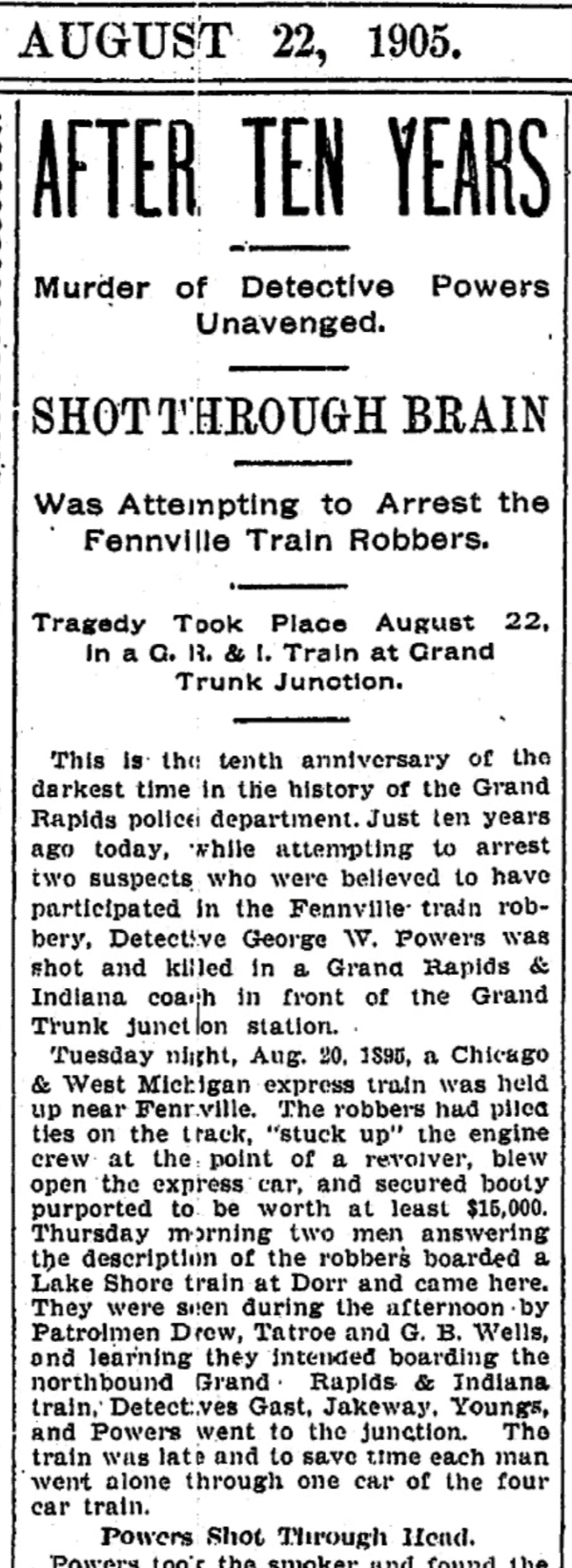
A decade later--The Grand Rapids Press 22 Aug 1905
The pall bearers were Charles H. Loomis, George W. French, Dr. D.J. Wallace, George Wolcott, Dr. S.D. Hinman and Fred Clifford, all members of the Masonic lodge of Sparta. The Sparta band led the cortege to the cemetery, one mile east of the village, and the Masonic fraternity and the Grand Army and Third Regiment comrades followed as an escort on foot, with scores of farmers' teams bringing up the rear. The service at the grave were according to the Masonic ritual, conducted by Prof. J.G. Van Winkle.--The Grand Rapids Press (26 Aug 1895)
Ink to paper across the state and beyond echoed the (31 Oct 1895) item in the Mount Clemens Press that proclaimed Smalley Did Not Murder Powers. "It is said that John Ambrose Smalley, who was shot and killed by detectives at McBain really had nothing to do with the killing of Detective Powers the night after the robbery. A perfect alibi has been undoubtedly proved and the officers admit it, but it is just as certain that he planned the entire affair and thus had a guilty knowledge of it." Eyewitness affidavits were notarized that the suspect was 75 miles away from the crime scenes visiting friends and relatives at the time of the robbery and when the detective was killed.
John Smalley was gunned down after failing to give himself up by two deputy sheriffs and their posse out of Cadillac on the supposition he was their man. Theories included a possible double, but ultimately, thought prevailed the real culprit was his younger brother, Abe, who was onboard the ill-fated train and somehow vanished.
In Retrospect
The headlines printed in Grand Rapids' The Evening Press (22 Aug 1905) says it all. After a decade and extensive manhunt, coast to coast, the investigation was closed and the reward withdrawn. "How the men escaped is a mystery still... John Smalley was located in a small shanty near McBain, Missaukee county. At the order to surrender he kicked to the door of the shanty and began working his six shooter, but a Winchester bullet came through the door and Smalley fell dead. Many still believe John Smalley did the shooting, but the police are certain that Abe, the younger, killed Detective Powers. After a delay that doubtless gave Abe the start he needed, the police began again the search. Abe Smalley was trailed through the south and west, but got away and has not been heard from."
In spite of the police force's best efforts, justice was never served.
Mad Dogs &
Marshal Meeker
Albert H. Meeker
The son of Allen & Electa (Hilton) Meeker, Albert was born on June 6th, 1852, at Sparta and grew up near Lisbon. In 1877, he married Ida May Boorom and worked on the family farm. Ida's parents were Anthony & Sally M. (Finch) Boorom. Albert lost his wife in 1886 and married again in 1890 to Nora, the daughter of John & Julia E. (Chambers) Brown. The Meekers were blessed with four daughters.
When the 1900 Federal Census was enumerated, the Albert Meeker family resided in Sparta. His occupation was that of a “produce dealer” while he earned a living as the owner of an apple-drying business situated between Maple and what would later become Washington Streets, south of Centennial. But that’s a story in itself for another time.
- I Remember Sparta's First Mad Dog Scare by Arzie Pinckney
published in the Sentinel Leader Dec 2, 1964
Late one afternoon a young lady by the name of Myrtle Miller was on her way home after a day's work in the Tyroller Clothing and Millinery Store, now the Paris Bakery. She lived with her parents, Mr. and Mrs. Frank Miller on the first farm east of the river bridge on the south side of the road... As she was crossing the first bridge, she met a large shepherd dog. She stopped, talked to it and petted it, and went on her way.
The dog came on and the first dog it met was one that belonged to Roy Wallace. (He lived where Tom Feerick now lives.) Roy's dog was always running out and snapping and barking at everyone that passed their house and we kids were scared of it. When the shepherd dog came along, Roy's dog rushed out barking at him as usual. He chased him up on the porch and bit him, then went on his way up the street and bit several other dogs but did not seem to pay any attention to people.
The news that a mad dog was loose in town spread like wild fire. Everyone that had a gun, pitchfork, or any other kind of weapon joined the hunt. Most of them were out all night. Just after daylight, our town marshal, Mr. Albert Meeker, caught sight of him. He was a crack shot with a rifle and one shot was enough. The dog's head was sent to Ann Arbor to be examined and sure enough the report came back that he did have rabies. You may be sure that everyone was thankful that Al got the dog before the children started school.
Mr. and Mrs. Meeker were the parents of Mrs. George Brace, Mrs. Bert Young, Mrs. Inez Stebbins, and Mrs. Theodore Baker, Sr. Al was a real nimrod. For years he made his trek to the north woods and the deer country and seldom came home empty handed. He made his last trip in his 89th year. When he got home, he cleaned and oiled the old rifle and hung up his hunting outfit.
As soon as the news came from Ann Arbor, there was a round-up of dogs. At that time, there was no law in the village governing dogs, so most of them ran loose. Unless you had a special pet, they had the run of the village. So every dog that was known to be a philander and a loose liver was under suspicion that he might have been bitten or been with the mad dog. He was gone over with a fine tooth comb and if they found a fresh mark or scratch on him and if its owners didn't have an iron clad alibi, it was curtains for him.
Even the St. Bernard of Dr. Griner’s didn’t escape the executioner. He was a huge animal. I believe that he was the biggest dog that ever came to Sparta. He looks as though he could carry a good-sized keg of brandy or whatever it was that dogs were supposed to carry in snowstorms. He was the most gentle brute and all the kids loved him as soon as they got over being afraid of him. But he couldn’t explain where he was on the night in question, so he bit the dust.
There was a shortage of dogs in the village for quite awhile. We seldom heard of a dog barking at the moon or every time there was a train whistle or the church bells rang. It took quite awhile to get the dog population back to normal. Meanwhile, the cats had a long holiday and they got fat and lazy because there were so few dogs to exercise them for most of the dogs were home on a chain.
It was March of 1903 when Arzie’s mad dog story took place. Various newspaper accounts reveal more than one mad dog was recently on the loose in Sparta—within the month.
The Isabella County Enterprise article with the headline of Mad Dog Ran Wild. read: “Sparta, Mich., March 18.—A mad dog ran wild in the streets here Monday night, biting all that came within reach until yesterday morning, when it was shot by the marshal. There has been great excitement here in consequence. Both the township and village boards of health have held meetings and ordered all dogs muzzled, and all that have been bitten are to be shot. Seven dogs were killed yesterday and more are to follow.”
Excited Over a Mad Dog. headed the report in the Osceola County Democrat. “Sparta, Mich., March 20.—A mad dog ran loose all Monday night, biting all other dogs that came in its path. The dog was killed Tuesday, but the town is excited and a wholesale slaughter of dogs is going on. This was the second case of the kind within three weeks. Children are being kept off the streets, and many citizens will not venture out of doors unless they have heavy clubs or revolvers.”
The prospect of a mad dog roaming the area caused fear in the citizenry as a bite from an affected animal would cause rabies, also known as “hydrophobia”. It was commonly called that because the afflicted were known to avoid even the sight of water. An incident at Owosso in Shiawassee county, Michigan, in 1901 stated that an eight-year old boy had been bitten several weeks prior with the wound being cauterized which was thought to prevent the disease. He began showing symptoms which were getting worse. “Part of the time it has required the efforts of four men to hold him in bed.”
The fear was real.
The Sentinel-Leader reported on January 11, 1907, about an “epidemic of hydrophobia” which took place at a small outpost named Smith’s Crossing in Saginaw county as a “mad dog came down the river road from the direction of Midland biting everything in its path. It was finally dispatched by a farmer, whom it attacked, after a fierce battle. So vicious was the dog that the farmer’s horses would not pass it in the road, trembling in their tracks. He beat it off and later with a neighbor killed the animal.” Not only were people and other dogs at risk, but any animal bitten--wild or domestic. “Within the last few days every dog in the hamlet has gone mad, four foaming-mouthed canines being killed in one day. Three hogs belonging to one man went mad from hydrophobia and five cows owned by another villager have become rabid. The cows went rearing and plunging about the barnyard, bellowing with all their might and biting each other. It is believed that many other cattle and hogs, and possibly horses, have been bitten.”
A Ludington widow, Mrs. William Moran, and her ten children were believed to have contracted rabies in 1909 “by drinking milk from a cow recently bitten by a mad dog. They have been rushed to the Pasteur Institute at Ann Arbor.” Reported the Osceola County Democrat. The French scientist, Louis Pasteur, had facilities in the region at the University of Michigan in Ann Arbor, and Chicago, Illinois, where people were treated for rabies with his life-saving serum. As time was of the essence, communities often raised the necessary funds and provided transportation for the unfortunate victims.
The Lansing State Journal included a news brief in their August 3, 1916, issue to alert the public: “The state live stock sanitary commission has placed a quarantine on all dogs in Sparta township for 60 days. Hydrophobia is reported in the township. One dog has been chasing farmers.”
Indeed we are fortunate to be living in an age where mad dogs no longer freely roam and rabies outbreaks are rare.
Contact
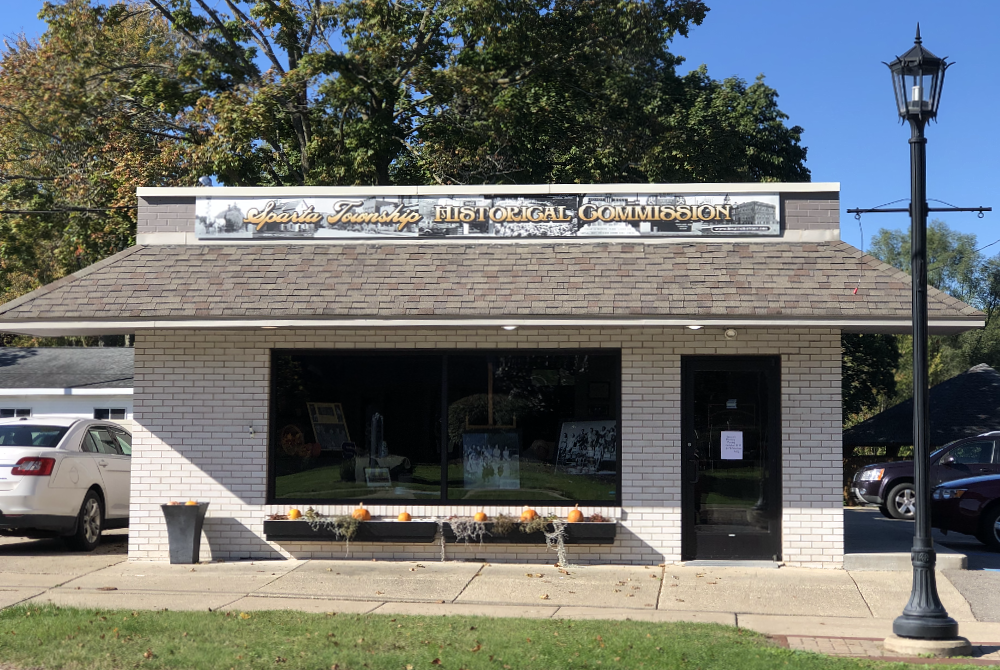
Sparta Township Historical Commission headquarters at 71 North Union Street
Our History Center is conveniently located at 71 North Union Street in downtown Sparta. Please join us for coffee and lively conversation on Monday mornings. Visits to the History Center can also be scheduled by appointment, for your convenience.
We do not receive mail at the History Center, instead, please use our mailing address, which is:
attn: Sparta Township Historical Commission
Sparta Township
160 E. Division St.
Sparta MI 49345
Our complete archives are now available online for your convenience. Just click STHC PastPerfect Catalog Access and begin your research!
For other inquiries, the Sparta Township Historical Commission can be reached by phone at: (616)606-0765 or via email at the following address:
